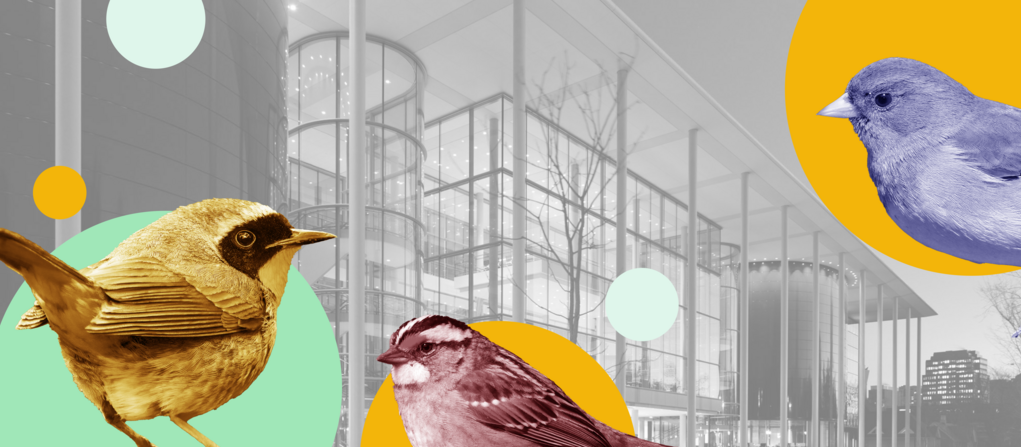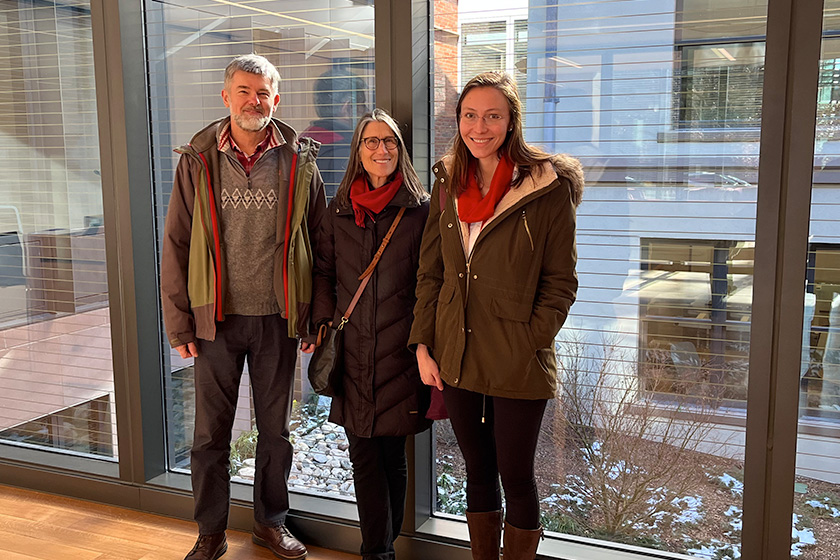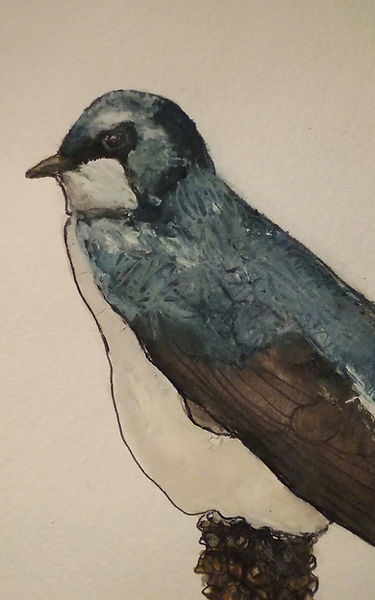
On a brisk October morning last fall, Viveca Morris and Kristof Zyskowski were canvassing Yale’s campus in search of “bird strikes”—songbirds killed after colliding with glass windows. After a few minutes of scanning sidewalks and lawns, they found a casualty: a ruby-crowned kinglet, so named for its bright orange crest.
With a gloved hand, Zyskowski carefully picked up the bird while Morris photographed it to log in iNaturalist, the mobile app they use to catalog data such as location and species of birds they collect during monitoring walks. Every struck bird they find moves them a step closer to finding solutions to a major biodiversity challenge: the more than 1 billion birds killed by window collisions every year in North America.
The research taking place this fall morning is part of the Yale Bird-Friendly Building Initiative, a collaboration between the Law, Ethics & Animals Program at Yale Law School (where Morris is Executive Director), the Yale Peabody Museum of Natural History (where Zyskowski serves as Collections Manager for Vertebrate Zoology), the Yale Office of Sustainability, the Yale Office of Facilities, and the American Bird Conservancy.
With support from a seed grant from the Yale Planetary Solutions Project, the Initiative is conducting two research projects in the 2022–2023 academic year, drawing on the expertise of Yale faculty and staff across multiple departments and disciplines and using the campus as a living laboratory to advance biodiversity protection and research.
Halfway into its yearlong study, the Initiative’s research has already yielded critical insights about where bird strikes are occurring—data that will help inform retrofits and new building design standards that could drastically reduce avian mortality.
“Our hope is that Yale will become a gold standard model for how universities nationwide can become more bird-friendly both by addressing existing and new buildings,” says Morris.
‘This is Absolutely Fixable’
Birds are a critically important, though often underappreciated, part of a thriving ecosystem. They pollinate plants, disperse plant seeds, and feed on a variety of insects and rodents, to name just a few benefits. Birds dying from window collisions is a long-standing problem on a global scale, but one that has come to greater public awareness as the climate and biodiversity crises have accelerated.
“Birds are one of the best indicators of the health of an environment,” says Zyskowski. “Like the old saying: the canary in the coal mine.”
Bird collisions on or near Yale’s campus have been informally reported since at least 2005, with Facilities staff, citizen scientists, and others reporting strikes to Peabody staff. The Bird-Friendly Building Initiative’s current study, however, is the first to comprehensively and systematically study the issue.
This past fall, the Initiative hired eight Yale students as research assistants to monitor for bird strikes during the fall migration. Equipped with the iNaturalist app and Ziploc bags, the students walked one of three routes—around central, medical, or west campuses—five days a week to document and collect struck birds. They’ll repeat the monitoring for another eight weeks during the spring migration in April and May, when birds return to northern climates. Every bird collected is added to the Peabody’s research collection after being prepared by undergraduate research assistants working under Zyskowski’s direction—furthering their professional development as biologists, ornithologists, and museum professionals.
Data from the fall migration confirm what Morris and Zyskowski already knew anecdotally: that bird strikes occur at many campus buildings, but that some are responsible for an outsized share of bird collisions. That’s important, explains Morris, because it means that targeted mitigation—retrofitting select glass facades with “feather-friendly film”—could have a significant impact.
The Initiative’s data will also help enhance bird-friendly standards Yale adopted in 2019 as part of planning for campus construction and renovation projects. Already, these design standards are being realized around Yale. The newly opened building at 87 Trumbull Street, home to the Department of Economics and the Tobin Center for Economic Policy, is the first new building on Yale’s campus constructed with bird-safe fritted glass—a milestone for campus sustainability.

Similarly, the renovation of the Peabody Museum, which houses Yale’s encyclopedic collection of bird species, will feature windows etched with bird-safe fritting, helping birds to recognize them as a structure to be avoided. On Yale’s West Campus, the Collections Study Center last fall applied patterned CollidEscape film to a glass walkway surrounding a courtyard to help birds distinguish the façade from open air. And Yale School of Management is experimenting with similar window applications at Edward P. Evans Hall.
“This is an environmental problem that is absolutely fixable and avoidable,” Morris says. “It’s exciting to have the Planetary Solutions Project invest in this because it helps recognize that sustainability of a campus must include the protection and sustainability of wild animals.”
Crafting Model Policy for Bird-Friendly Cities
The second part of the Yale Bird-Friendly Building Initiative’s research focuses on investigating the experiences of cities that have passed bird-friendly laws in order to help more cities do the same. With Morris, Yale Divinity School student Meredith Barges is researching existing bird-friendly building policies in five U.S. cities: Madison, Wisconsin; New York, New York ; Cupertino, California; Arlington, Virginia.; and San Francisco, California.
 Barges has conducted interviews with dozens of bird conservationists in those cities, as well as with government officials, local community organizers, architects, glass manufacturers and others involved in passing these bird-friendly laws. She is examining how comprehensive these policies are; whether they apply to residential or commercial buildings only; how public support was marshaled and what concessions were made; and how high on buildings bird-friendly materials must be applied (100 feet is the gold standard, she explains, though most cities cap the height at 75 feet or lower.)
Barges has conducted interviews with dozens of bird conservationists in those cities, as well as with government officials, local community organizers, architects, glass manufacturers and others involved in passing these bird-friendly laws. She is examining how comprehensive these policies are; whether they apply to residential or commercial buildings only; how public support was marshaled and what concessions were made; and how high on buildings bird-friendly materials must be applied (100 feet is the gold standard, she explains, though most cities cap the height at 75 feet or lower.)
Her findings have been compiled into five case studies for a report due out later this year, which other cities can use to craft their own bird-friendly regulations. She is also authoring a chapter on the benefits of bird-friendly building for net-zero cities.
“The goal is to show that bird-friendly building is a growing legal norm. More and more cities are taking this approach to address the steep decline in bird populations in North America,” says Barges, whose background is in advocacy and human rights law. “We hope to show the ways this type of policy is being done, the ways you can make a law better or worse, so people have resources when they go to draft their own laws.”
Barges is also co-chair of Lights Out Connecticut, a movement that aims to reduce bird collisions by making sure excess lights aren’t left on at night when most bird species are migrating. (Migratory birds are attracted to artificial light.) She was part of a group of students who persuaded Yale Divinity School to adopt a lights-out policy. A longtime birder who got involved in urban bird conservation while living in New York City, Barges is eager to accelerate the adoption of bird-friendly policies nationally.
“Cities are leading the way on bird-friendly policy, responding in ways that states and the federal government aren’t,” Barges says. “We’re trying to empower more cities to be leaders and continue this movement.”